Rolling acrylic paintings for storage and shipping is a fairly common practice, and many painters have likely rolled, un-rolled, and re-rolled their own paintings with some success. However, while we know it can be done, it is still not our best recommendation. There are definite risks to be aware of, such as the imprinting or ferrotyping of the surface, the sticking of interleave materials, and sometimes cracking if handled at cold temperatures. Some materials, like paper or bubble wrap, can also leave pieces stuck to the surface, creating a major restoration project that may never get the work back to its original state. The first part of this article will address these issues in more depth, and show examples of the type of damage that can occur when rolling acrylic paintings using some typical interleaf materials. In the second part, we will share what to do if you feel you must roll and ship your painting.
Testing
We tested 7 pieces of canvas painted with 1:2 blends of Fluid Carbon Black and Regular Gel in Gloss, Semi-Gloss and Matte sheens. These mixtures of 2 parts Gel and 1 part paint were applied in three areas on each piece of canvas with a palette knife, creating both smooth and textured surfaces, and allowed to dry for a week. The 10″ x 15″ pieces of canvas were then rolled paint side out on 2″ diameter cardboard rolls with a range of inter-leaving materials:
- No inter-leaving
- Polyethylene Plastic
- Dartek film (Nylon)
- Silicone Release Paper
- White Kraft Paper
- Tissue Paper
- Glassine
We also tested a panel that had a glossy acrylic surface wrapped with bubble wrap for several weeks at a range of temperatures. The damage to the surface is quite evident in the photo below:
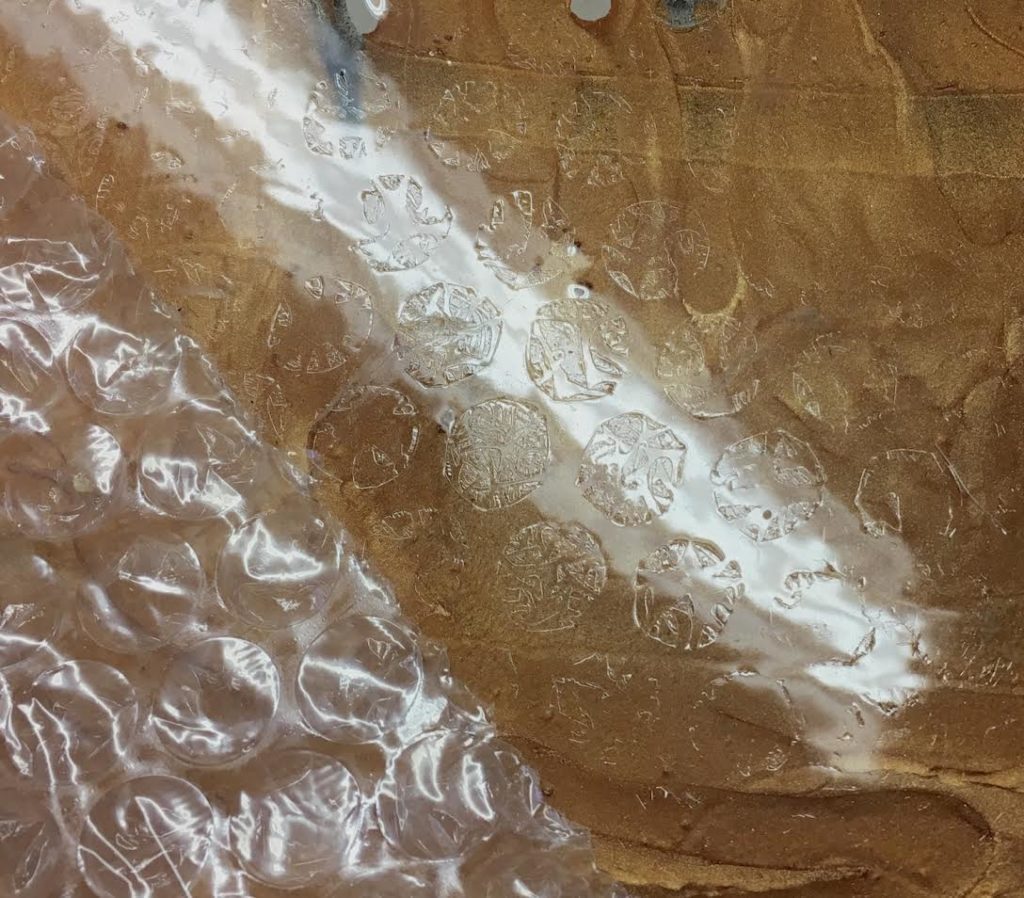
Temperature
Fine art grade acrylic paint and medium films are generally quite flexible, and so can be rolled easily at warmer temperatures, but this inherent thermo-plastic nature of acrylic allows it to go back and forth throughout its life, moving from very soft and flexible at warmer temperatures, to harder and potentially brittle at very cold ones. These changing characteristics can cause problems when the painted surface is in close contact with another surface for an extended period of time, or when suddenly flexed or shocked at cold temperatures.
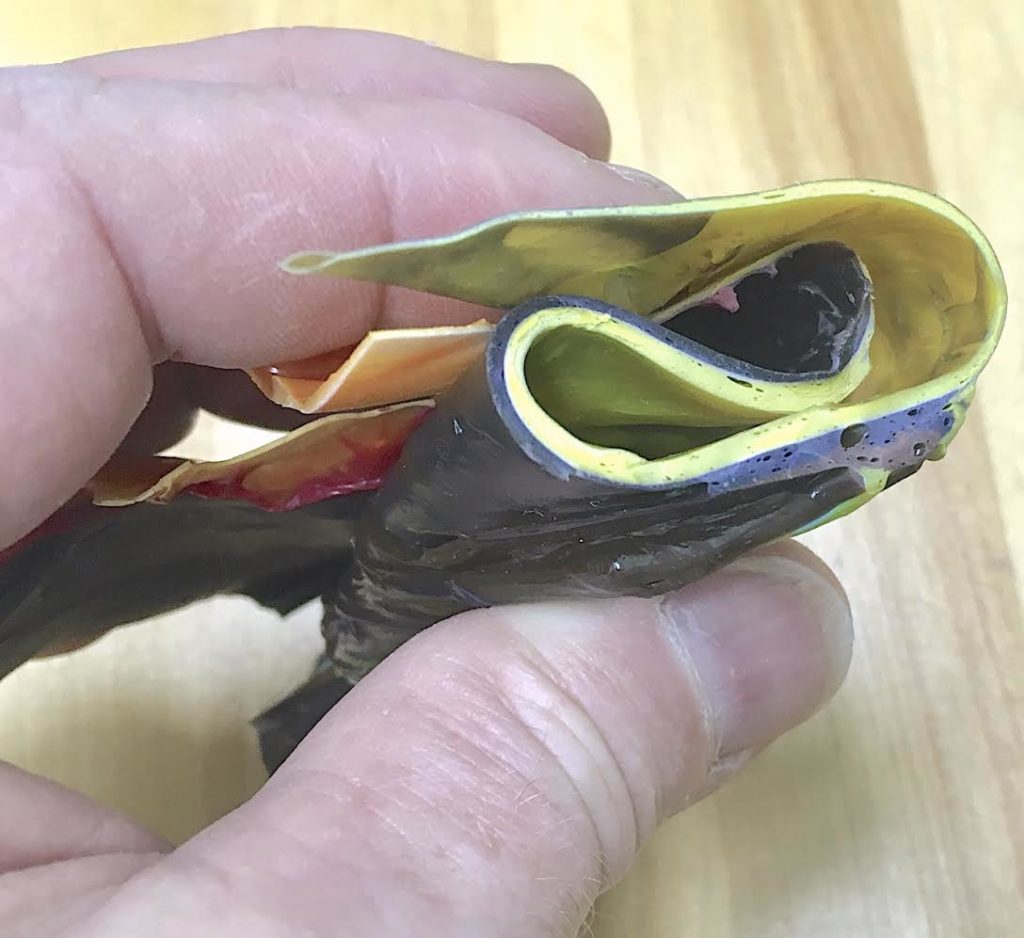

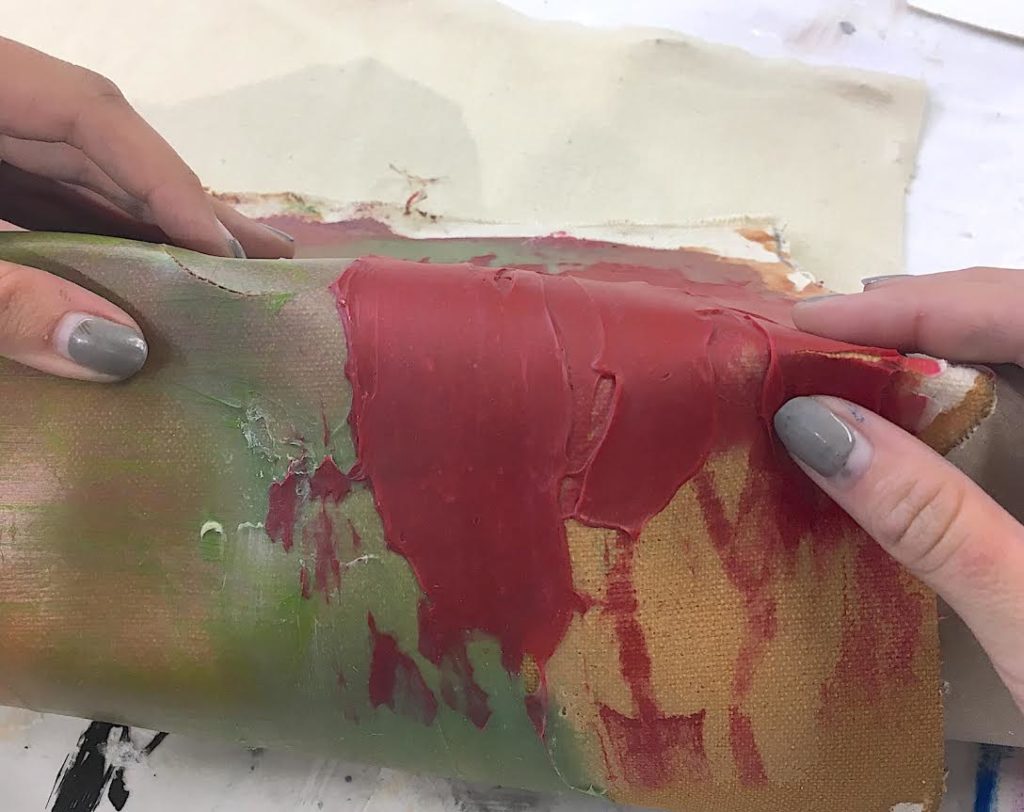
Interleaving Materials
Glossy acrylic paintings will be much more susceptible to imprinting and surface change, even if non-stick materials such as polyethylene plastic sheeting, or silicone release paper are used. With enough pressure, heat and time, sticking and ferrotyping can still occur. While polyethylene sheeting can be peeled off , its creases and even the micro-texture of its surface can still leave a lasting change. We have even seen silicone release paper stick to acrylic films after weeks of pressure and warm temperatures.
Matte surfaces will be less prone to sticking, but thicker layers can still be compressed and imprinted. A matte acrylic can also become glossy if burnished or pressed against a very smooth material, while a glossy acrylic can become matte if pressed against a textured one. Stain paintings, and very thinly painted matte surfaces, can often be rolled and unrolled with much lower risks and usually with no noticeable damage since the paint has become so integrated into the canvas or ground.
The following images point out the most significant damages. Polyethylene Plastic, Dartek Film or Silicone Release Paper were able to be removed without any tears, but there were still changes to some of the surfaces, especially any raised or textured areas. Rolling with no interleaf material was not terrible, but of course left canvas texture imprinted on raised areas and even some canvas fibers stuck in places. Rolling with the paint against the cardboard tube picked up fibers from the cardboard on glossy raised areas. As expected, it appears that relatively thinly applied acrylic paint, especially with lower sheens, can be rolled successfully with minimal visible changes to the surface, but we would still caution that we feel there will always be some risk.
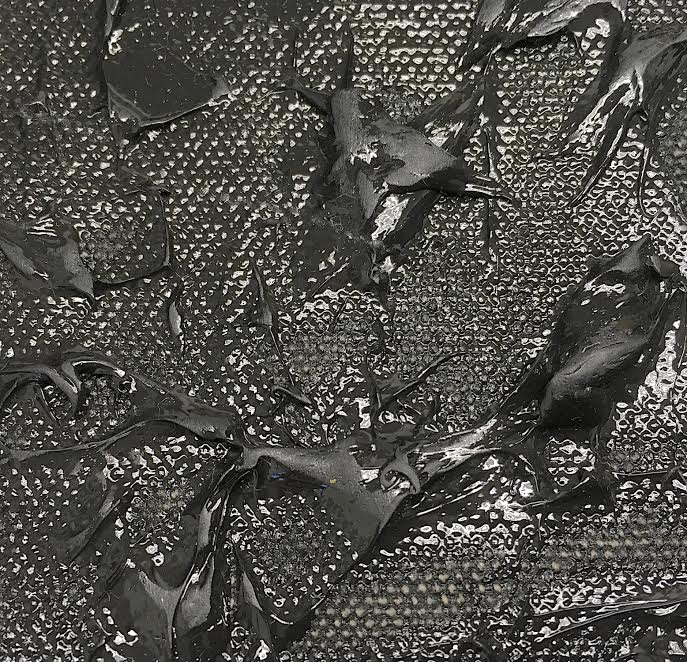
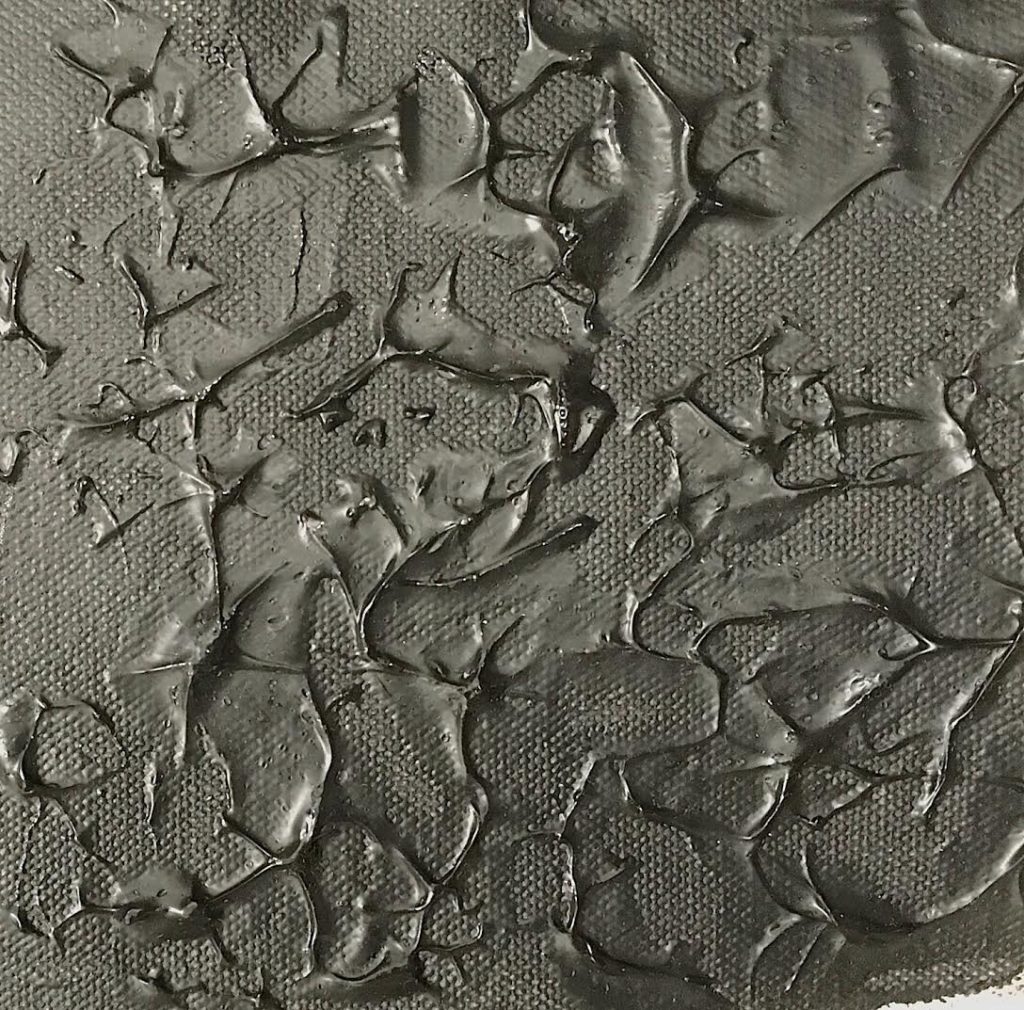
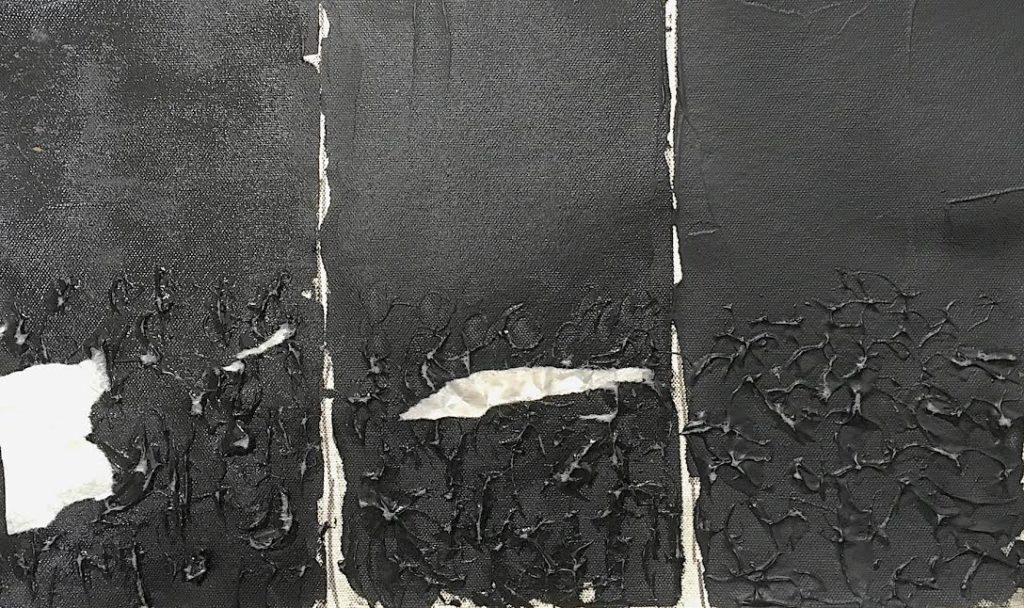

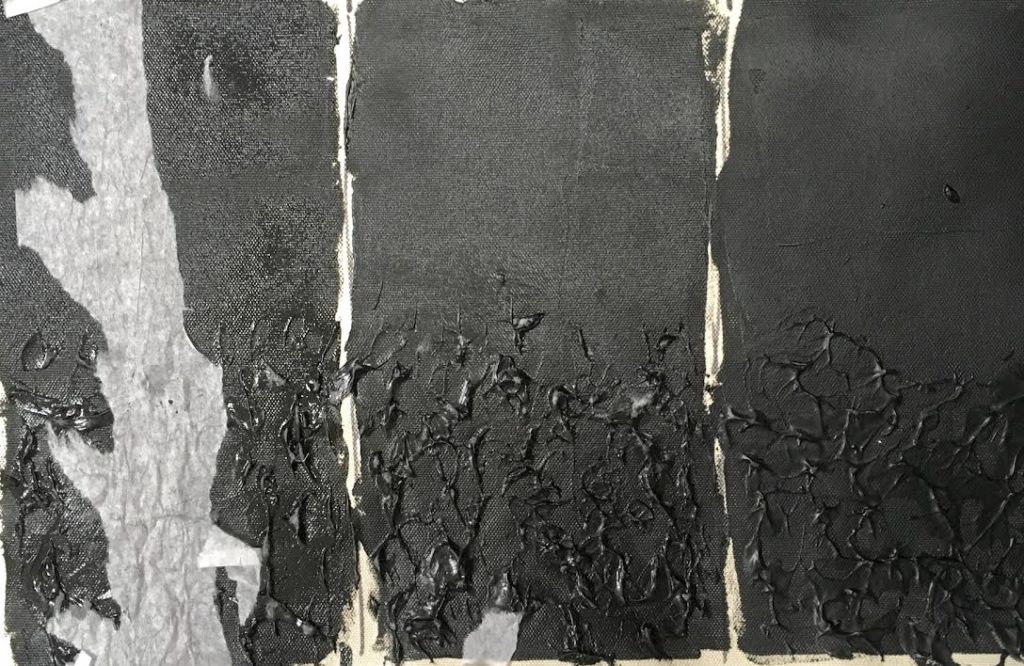
Paintings rolled with no interleaf material will tend to be imprinted by the canvas texture pressing directly against the surface, dulling glossy surfaces and sometimes causing canvas fibers to get stuck to the acrylic. Glossier paint in particular can stick to most surfaces and, even if the material can be peeled off, will leave a changed surface at some level. So simply using a material that does not stick to a relatively soft and tacky acrylic film does not insure success. It is better than peeling hundreds of small pieces of bubble wrap plastic or tissue paper from the surface of your painting, but the result is still a permanently damaged piece of art.
Recommendations
The only way to ensure that a painting will survive shipping or storage with no changes to the surface and appearance of the work is to have nothing touching the painted surface and nothing causing any pressure from either the front or back. This continues to be our best recommendation and something we have covered in this Just Paint article:
Safe Handling and Transportation of Acrylic Paintings
However, because this is not always possible, we wanted to provide at least one potential way to roll paintings that should help lessen some of the risks even if it cannot remove them altogether. Please note that the following method assumes rolling, unrolling and shipping in a climate controlled environment. As we showed earlier, acrylics can get quite brittle at colder temperatures and can crack if flexed, shocked or suddenly creased. As with all rolled paintings, this works best with a relatively thinly painted work having a satin or matte surface. The glossier the painting, and the thicker the textures, the greater the chance of damage.
A Method for Packing a Rolled Acrylic Painting for Shipping
Materials:
- Double wall custom box to accommodate measurements
- silicone release paper
- white foam roll 1/16th poly foam
- Thin wall 10″ Diameter tube, 4 “ longer than painting width ( sonotubes work well )
- Masking Tape
- ½” rigid insulation foam to line box and make “donut” at each end.
Method:
- Wrap 10” diameter tube in thin packing foam sheet. Foam can be spiraled onto tube. Leave 2 inches blank on ends of tube. Tube must fit into recessed holes at each end of the box.
- Painting is laid face-down onto silicone release paper. Thin foam sheet placed on top of this, covers back side of painting entirely. Foam sheet can be seamed with tape but seam/tape side doesn’t contact the canvas.
- Painting is rolled onto already-padded tube and secured at edges with tape.
- Painting roll is covered with plastic sheet but plastic is not contacting any surface of the canvas. Taped to secure onto tube so it doesn’t shift.
- Pre-cut “donuts” fit onto ends of tube. Secure with tape. The entire thing is placed into the box so the tube is suspended. 3-4 Inches around tube to sides of box. Nothing touches artwork other than the silicone release paper.
Artwork is suspended inside the box with very little pressure on the surface of the painted side of the work.
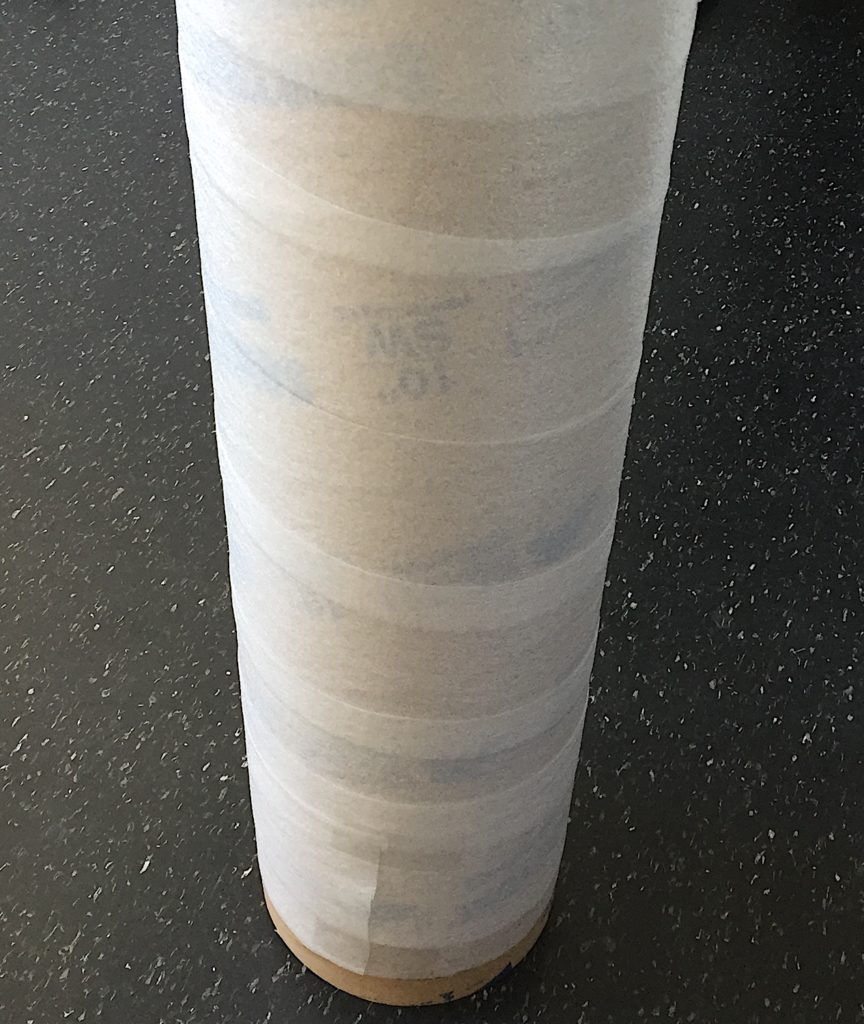
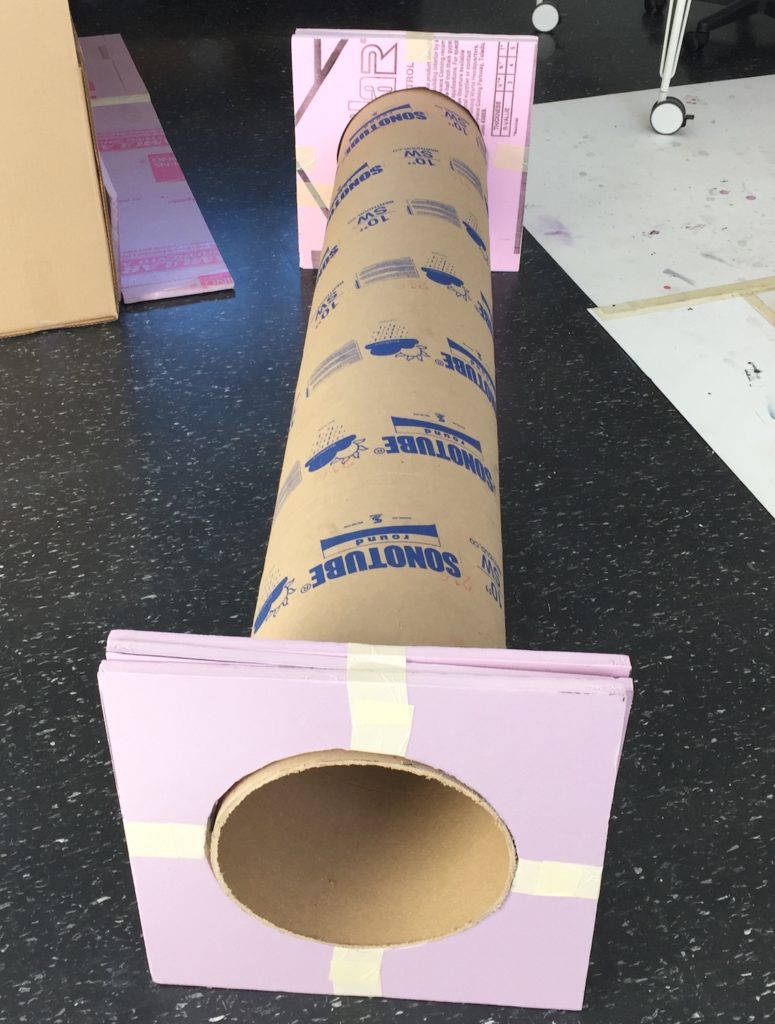
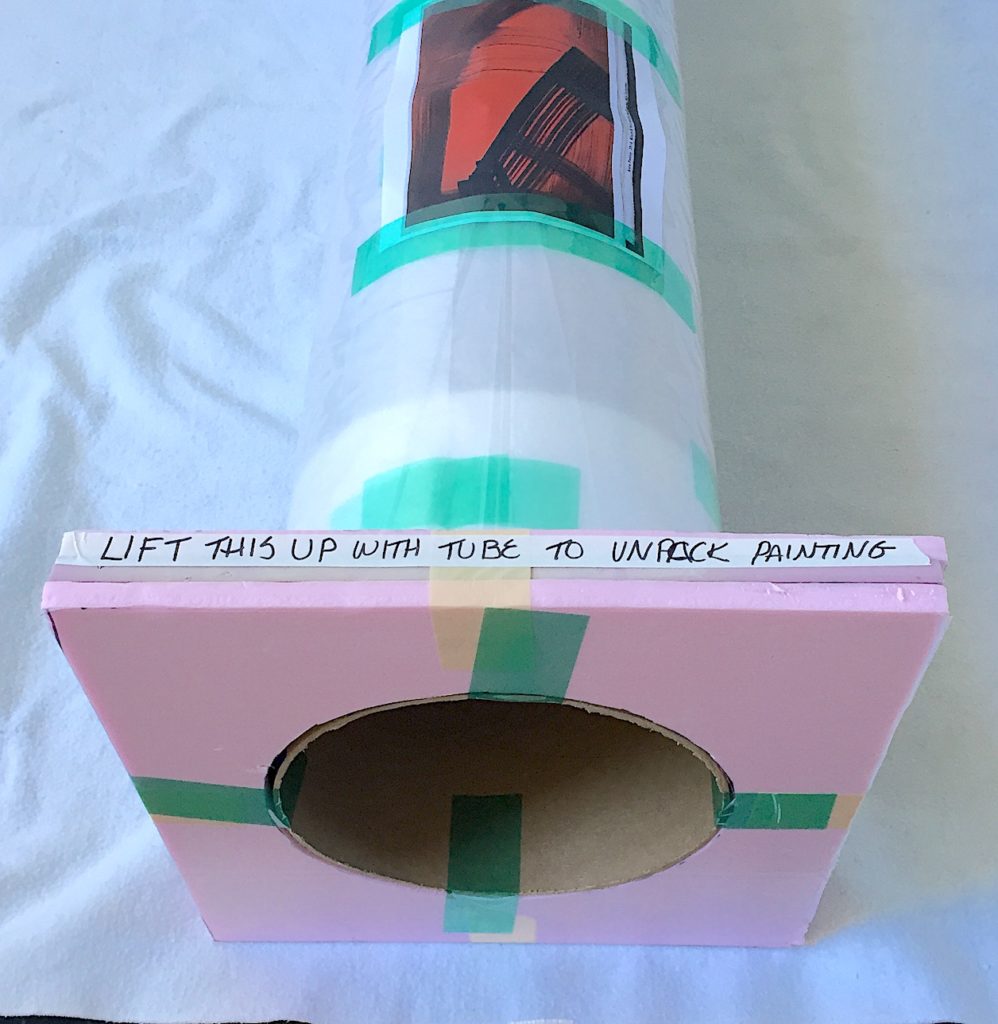

We would like to thank artist Kate Petley who was very kind and generous in allowing us to use some of her photos, ideas and methods for packing rolled acrylic paintings.
As always if you have questions, let us know in the comments or email us at [email protected].
About Scott Bennett
View all posts by Scott Bennett -->Subscribe
Subscribe to the newsletter today!

Thanks for your help,Scott. Very informative. Imam not shipping right now and need to store 30 5×7”. Acrylic paintings. You helped me through. The isolation layer and varnishing process a couple of weeks ago.
In my search at various stores ie container store, staples, michaels,etc. Imcame up,with a very Saturday “shirt box” with a cove. I have built ridges on the sides to form slots…for lack of a better word out of foam core. Ues, very time-consuming 🙄. anyway, it works and only about 1/8 “ of the edges of the painting slightly touch the foam core. I think it’s is pretty genius if I do say so myself.I haven’t been able to,find anything online like it. so my question for you is…..do you know of a product like I have built? Or am I heading for a patent? 😂
Hi Julie,
You are most welcome. While I am not completely sure I can picture your described method of storing a painting, as long as nothing is touching the painted surface, and the painting does not move around in the box, then it should work. We’ve used pizza boxes to store and stack works! As for a patent, we can’t comment on that, but we do know there are various art shipping boxes out there that might use similar methods. Here are links with related information for you:
A short video about one way to pack small paintings: https://www.youtube.com/watch?v=v7HPKy5sW30
Some resources for companies that make packaging for art:
http://airfloatsys.com/strongbox/
http://www.masterpak-usa.com/cat_101_strong.htm
http://www.uline.com/BL_2356/Deluxe-Artwork-Shippers?keywords=fine%20art%20packing
Best of luck with your work!
Wow this effect is so cool. Thank you I’m going to use this. I always wondered how you get that look on a painting.
Hi Vic,
We aren’t sure which particular effect you are referring to, but if you mean one of the ferrotyped surfaces, then it certainly could be possible to use one of these surface changed effects in a focused and intentional way. In fact, there is a technique where you can heat up a glossy acrylic surface with a hair dryer, making it softer and tackier for the purpose of adhering paper or other thin collage elements. The bubble wrap effect could backfire as if it sticks really well, it will tear into lots of little stuck pieces when you try to pull it off. If there is another effect you are interested in, just let us know!
Thank you for the article is an interesting approach that certainly limits impacting the canvas. The outter rectangular box will have to be strong enough to take an impact at its weakest point i.e. the middle. A second larger heavy duty tube suspended around the 10″ tube migh mitigate that. Alternatively a plywood crate should withtstand any hard knocks.
However…Step 4 though is confusing me – when you say “…Painting roll is covered with plastic sheet but plastic is not contacting any surface of the canvas…” – how is this possible?. The painting having been rolled facing outwards will have a certain amount of painted canvas exposed. How can this be covered by a plastic sheet without contacting the surface of the canvas?
Hi Thomas,
You are most welcome. And you are right, the outer box will need to be strong. Well built wood crates will be best for both rolled paintings and of course stretched paintings. In the past, we have recommended placing rolled and packaged paintings inside a second tube, and that tube can simply be the final container. And I am sure there is a way to suspend the inner tube inside the larger outer tube to create a similar situation. The answer to your question about how the plastic sheeting is not contacting any surface on the painting, is that the painting is covered with silicone release paper or film and the back of the canvas has the thin foam, so the plastic sheeting does not touch any part of the canvas or painted surface. We mention this under “Method”, # 2.
This was very helpful. I was wondering however, if this is a method you would recommend in transporting a painting via airplane?
Hi Heidi,
It is certainly possible that this method could be helpful if the work needed to be transported on an airplane, but we do not have any testing to offer any guarantees. We can tell you that vibrations from transport can cause some issues with stretched paintings, so a very carefully rolled, thinly painted acrylic painting, might be better off than a stretched on, in this case. The other potential issue with air transport is the possible cold temperatures in the cargo hold. Acrylic is thermo plastic and gets hard and brittle when cold, so movement presents a problem. Again, a carefully rolled painting might fare better. This is all assuming the crate is not dropped or shocked in some way during transit.
I am getting very information from this valuable post. it is a very helpful post about Rolling Acrylic Paintings for Shipping or Storage. I was wondering, however, if this is a method you would recommend in transporting a painting via Construction Hoist Lift?
Hi Joan,
We are happy that our article has been helpful for you. It is very hard to comment on the use of a “construction hoist lift” in moving a painting, as this method holds quite a lot of unknown variables in terms of potential sudden movement or shock. All we can say is that assuming the process is gentle and there is no sudden shock to the carefully rolled and crated painting, it could, in theory, work.
Hello,
Thank you for your detailed instructions on how to transport acrylic artwork safely! I was hoping you could post a link to a silicone release paper in particular that you prefer to use.
Thank you so much!
Katie
Hello Katie!
Thank you for your feedback and question. Here’s a link to Talas Online, where we obtain the type of silicone-impregnated release paper: https://www.talasonline.com/Silicone-Release . Let us know if you have any other questions!
– Mike Townsend
I heard that Tyvek would not stick to paintings and could be an alternative to silicone paper. Have you experimented with that?
thank you for the info! im new to the site and am going thru articles and man you guys kick ass!
question, i wrap my stretched canvases in glassine paper. along with stapling works that are not stretched on top of one another on my studio wall. I only staple the top portions of the canvas and in between those works i add a sheet of glassine paper. i havent attempted to unwrap the stretched works in glassine but my concern is should i be using something else to preserve my works? i’m not shipping them, merely wrapping them for storage to minimize dust buildup.
Hello Ramiro,
You are most welcome and thanks so much for your kind compliment! As you see in the article, glassine did not perform as well as silicone release paper or polyethylene plastic sheeting, in terms of potential sticking, so if you need to wrap acrylic paintings then its best to either use polyethylene plastic sheeting ( 4 mil ) or silicone release paper. The Poly plastic sheeting is easily available in hardware stores in large rolls and may be the simplest way to go. But, again, as the article discusses, there is nothing that can stop imprinting if there is enough pressure over time. Any material will imprint its surface onto an acrylic film if pressed to the surface long enough. And of course, warmer temperatures increases the potential. For stretched works I would recommend loosely wrapping in polyethylene plastic sheeting. You can use cardboard corners to enable the plastic to be spaced from the paint surface. This is one of the positive aspects of having frames of some kind on paintings, that extend a bit beyond the painted surface, as then there will be a space between each painting when placed one in front of another in your storage racks. I have many works on canvas that I also store stapled to a studio wall so I completely understand this. What I can tell you is that with enough paintings stacked this way, the weight eventually compresses the paintings and I have seen sticking and ferrotyping over time, especially with the paintings at the bottom. I have not been using anything in-between, but again, polyethylene plastic sheeting is probably easiest and best, other than silicone release paper. A lot also depends on how thick the acrylic paint is, how glossy it is, the temperature, and the number of paintings hung this way. I hope this helps!
It’s good to know that it can be rolled easily at warm temperatures. My brother was telling me last night about how he is needing to get some mailing tubes to ship his art that he sells to customers, and he was wondering how he can roll his acrylic paintings. I’ll make sure to pass these tips along to him once he finds some mailing tubes to ship his art in.
Hi Kate,
Please keep in mind that the bottom line in this article is that we do not recommend rolling acrylic paintings, due to the high potential for some level of damage to the acrylic surface. There are some exceptions with very thinly painted matte acrylic surfaces perhaps, or purely stained acrylic paintings, but otherwise, there can be no guarantee that there will not be some sticking of packing materials or imprinting or ferrotyping. The somewhat complex method I describe for packing a rolled acrylic painting with padding and with the roll suspended inside the container apparently has worked for the artist who designed the method, but again, variables in the painted surfaces of acrylic paintings can produce other results.
Thank you for sharing this information about rolling acrylic paintings for shipping or storage. It was useful and interesting. You indeed have written it in a layman way so that anyone can understand and work accordingly. You have done a great job… Great post!!
You are most welcome! Thanks for your kind comment and compliment. If you have any questions that we can help you with, don’t hesitate to contact us at [email protected], or call us at 607-847-6154 or
Toll-free (USA only): 800-959-6543.
Hello,
Very helpful article, thank you! I am curious on your suggestions on shipping an acrylic painting with glossy varnish, on panel/canvas with no frame. I’ve encountered issues with glassine getting stuck to the surface (easily removed), as well as bubble imprinting through when using tyvek. As it is impossible to not cover the surface, I was curious to see if you had any suggestions?
Thank you!
Erica
Hi Erica,
It is ideal to box acrylic paintings without anything touching the surface. Check out some of the suggestions in this article: https://justpaint.org/pack-and-ship-unframed-paintings-with-cardboard-corners-and-rails/
If you have additional questions, contact us at [email protected] and we can troubleshoot together.
Best,
Greg
Your tips are truly informative and inspiring. I hope to see more blog posts soon.
Thanks Victoria!